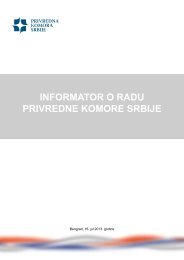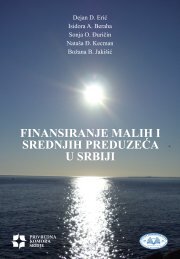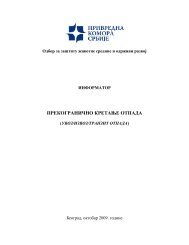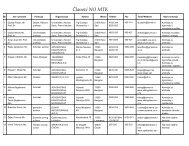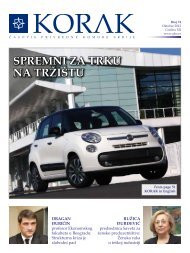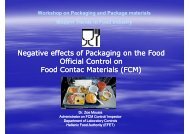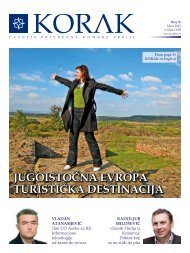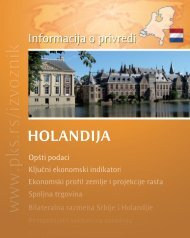INDUSTRIAL POLICY OF SERBIA 2011-2020
INDUSTRIAL POLICY OF SERBIA 2011-2020
INDUSTRIAL POLICY OF SERBIA 2011-2020
Create successful ePaper yourself
Turn your PDF publications into a flip-book with our unique Google optimized e-Paper software.
MANUFACTURING INDUSTRY-trendGROWTH RATE 2010/2001MANUFACTURINGINDUSTRY 0.4Food 1.3Textile -8.7Clothing -17.2Leather -9.0Wood -16.6Coke and oil 8.4Chemical 5.1Rubber and plastic 1.6Non-metals -2.9Metals 6.22520151050-5-10-15TREND <strong>OF</strong> MANUFACTURING INDUSTRY 2003-2010yoy growth ratestrendMetal products 0.1Machines anddevices -2.9Electronic 3.2Transport -7.4Recycling 2.2-20-252003 2004 2005 2006 2007 2008 2009 2010Source: RSO and RDB5
MANUFACTURING-employment and earnings2009Average netearnings=100Manufacturing 80Food 91Textile, leather,footwear45Wood 47Coke and oil 166Chemical 122Rubber and plastic 84Non-metals 83Metals 106Metal products 64Machines anddevices83Electronic 76Transport 68EMPLOYMENT DEVELOPMENTSIN MANUFACTURINGINDUSTRY (in 000)2009 2009/2007Serbia 441 84.6Hungary 793 90.7Romania 1,751 88.7Bulgaria 714 93.1Czech 1,243 88.4Slovakia 565 89.1Source: EUROSTAT, RSO8
MANUFACTURING INDUSTRY-FDI350030002500FDIEUR m3323Share of FDI in total investments (%)2006 2007 2008EU 27 19.4 23.4 13Bulgaria 93.4 99.5 55.3Czech 15.6 24.7 20.6Hungary 38.5 27.2 27.2Romania 36.2 19.6 20.1Slovakia 31.7 16.7 13.9Slovenia 6.3 11.1 11.9Croatia 27 32.4 22.9Serbia 70.7 36.6 25.5Source: UNCTAD, RDB2000150010005000Source: NBS184500119477412501821182414012001 2002 2003 2004 2005 2006 2007 2008 2009 2010-XFDI 2004-201025%Manufacturing75% other654Source: NBS9
EFFECTS <strong>OF</strong> GLOBAL RECESSION2010 2009Budget deficit-4,3-4,8InflationEarnings-2,526,69COMPOSITE INDEX <strong>OF</strong>ECONOMIC ACTIVITYEmployees-6-4Imports-285,2Exports-2012Investments-235ManufacturingGDP-15,8-3,11,54,1%-30 -25 -20 -15 -10 -5 0 5 10 1511
TRANSITION <strong>INDUSTRIAL</strong><strong>POLICY</strong> 2001-2010It targets:Privatization and restructuring of economyAttraction of FDICreation of a competitive business environmentStrengthening of the entrepreneurial sectorChanneling of development incentives and subsidiesThe transition model has rested on the increase of FDI.Major objective: reduction of unemployment and foreign trade deficitThe main criteria for extending greenfield subsidies are:Export-oriented productionNew jobs12
<strong>INDUSTRIAL</strong> <strong>POLICY</strong>-Survey research into competitiveness of Serbian industry (2)Main findings: Environment (48%) and the infrastructure in place (39%) are largely unfavourablefor R&D and innovation activities - 81% of companies believe the state does notencourage investment in R&D through its measures 70% of industrial products is launched on the domestic market;75% of needs ofindustrial enterprises is satisfied by suppliers from Serbia Most significant factors of business competitiveness: product quality (97%),established reputation (95%) and a specialized product (91%). Least citedcompetitiveness factors are marketing skills (69%) and product promotion anddesign (74%) The quality of expert staff (62%) is at a much higher level than the management ofhuman potential (46%); only 11% of companies provide scholarships for deficit skills Cooperation with companies from the EU has not increased considerably (39%) – anabove average assessment on the improvement of international competitiveness wasmade by the majority foreign companies (66%), export-oriented companies (76%)and medium-sized enterprises (60%) Businessmen (84%) are aware that FDI is an important source of the country’stechnological progress and an overall competitive position of the country* Figures in brackets denote % of positive answers15
<strong>INDUSTRIAL</strong> <strong>POLICY</strong>-Survey research into competitiveness of Serbian industry (3)SWOT analysis% companiesStrengthsProduct 90.2Business reputation 71.1Human resources 52.8WeaknessesBusiness environment 70.0Processes/procedures 45.6Market- suppliers 42.4OpportunitiesProduct 82.9Human resources 57.2Business reputation 54.2ThreatsBusiness environment 63.4Low prices 43.6Processes/procedures 41.516
<strong>INDUSTRIAL</strong> <strong>POLICY</strong> <strong>OF</strong> <strong>SERBIA</strong> <strong>2011</strong>-<strong>2020</strong>-objectivesDynamic and sustainable industrial growth and developmentA proactive role of the state – institution buildingEnhancement of investment climateStrengthening of competitivenessFaster development of entrepreneurshipIncreased and restructured exportReforms of the educational system in line with needs of theeconomyActive and dynamic cooperation between science and industryStimulation of innovationReforms of the labour market and employment policyThe balance struck between the stabilizing, development, andthe social role of the stateDevelopment of regional industrial centres and regionalbusiness infrastructureImprovement of energy efficiency18Environment protection
<strong>INDUSTRIAL</strong> <strong>POLICY</strong> <strong>OF</strong> <strong>SERBIA</strong> <strong>2011</strong>-<strong>2020</strong>-measuresMeasures focusing on:The building up of aninstitutional framework andbusiness environmentStrengthening ofcompetitiveness andproductivityDevelopment ofentrepreneurship, i.e. the SMEsectorEfficient implementation ofrestructuring and privatizationStrengthening ofcompetitiveness of somesectors throughimplementation of horizontaland vertical measuresRegionaldevelopmentEntrepreneurshipForeigninvestmentRestructuringandprivatizationEnvironmentprotectionEnergyefficiency<strong>INDUSTRIAL</strong><strong>POLICY</strong>CompetitionEmploymentCorporatemanagementReforms oftheeducationalsystemICTTechnologicaldevelopmentResearch anddevelopment19
STRENGTHENING <strong>OF</strong> <strong>INDUSTRIAL</strong>COMPETITIVENESS-educationThe prerequisite for sustainable competitivedevelopment of industry is the transformationof education.The rate of employment of those with higheducation in Serbia 20%, and the EU average 28%Education is taking on the character ofinvestment.The reform of expert education is a continualprocess that requires:Flexible vertical and horizontal flows within theeducation systemEmployers’ involvement in the process ofascertaining the necessary qualificationsIntroduction of the system of quality insuranceinto the educational processEDUCATION-BASED RATES <strong>OF</strong>EMPLOYMENT 2009Primary Secondary HighEU-27 22.3 49.3 28.1Bulgaria 14.4 59.5 26.1Czech 5.3 77.7 17.0Hungary 11.8 64.2 24.0Poland 8.1 66.3 25.6Romania 22.4 61.7 16.0Slovenia 13.0 61.3 25.7Slovakia 4.1 77.9 18.1Croatia 15.3 63.8 20.9Serbia 23.7 55.4 20.1Source: RSO, Eurostat20
STRENGTHENING <strong>OF</strong> <strong>INDUSTRIAL</strong>COMPETITIVENESS-technological development and innovationsTechnological development – 3 stages:I.Revitalization – consolidation of industrial systemsII.Re-engineering – expansion through technological modernizationIII.Development – a change of the technological profile of industrytowards high-tech areasThe instrument of technological development:National Technological Platforms of Serbia (NTPS)Innovation – the propeller ofeconomic and overall socialdevelopmentForming of the National InnovationSystem – a network of institutions fromthe private and public sector thatthrough their interactions initiate,import, modify, and expand innovationsТECHNOLOGICAL PR<strong>OF</strong>ILE <strong>OF</strong> INDUSTRY(GVA)7,516,450,725,4Low-tech (LT)Medium low-tech (MLT)Medium high tech (MHT)High-tech (HT)Source: RDB21
STRENGTHENING <strong>OF</strong> <strong>INDUSTRIAL</strong>COMPETITIVENESS-energy efficiencyThe strategic objective of the EU is to improve energy efficiency by20% before <strong>2020</strong>.The level of energy intensity of Serbia is 6 times higher than the EUaverageImprovement of energy efficiency is one of the preconditions forindustrial development – it directly influences competitivenessEnforcement of EU directives is obligatory for Serbia under the Contracton the Establishment of Energy CommunityLaw on Rational Energy Use defines:A long-term national programme of rational energy useThe level of energy efficiency and minimum standardsEnergy managementIncentives for the realization of projects of more efficient energy use22
STRENGTHENING <strong>OF</strong> <strong>INDUSTRIAL</strong>COMPETITIVENESS-environment protectionObjectives for industrial development:Fostering the development of cleaner production,introduction of the system of environment management(EMAS) in industrial plants, developing social accountabilityReduction of pollution and pressures on environment (Serbiahas a 9 times higher emission of carbon-dioxide per unit ofGDP than the EU average)Protection and improvement of environment (reparation ofcontaminated locations, filtering of industrial waste waters,management of waste flows)23



